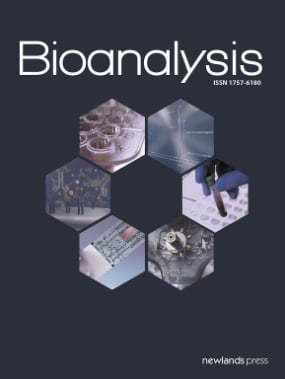Share this
COVID-19 Spurred Mitra Microsampling Innovation in Bioanalysis
by Neoteryx Microsampling on September 23,2021
 September 2021 — According to a preprint article slated for publication in the next issue of the journal Bioanalysis, the COVID-19 pandemic led to a shift in the way blood samples are collected for bioanalytical research and other studies. Authors James Rudge, PhD and Stuart Kushon, PhD provide context for the expanded and innovative use of remote sampling methods in 2020-21 by recounting how widespread lockdowns limited people's access to research and medical facilities. Drs. Rudge and Kushon, who co-developed a remote sample collection technology with volumetric absorptive microsampling, Mitra® devices based on VAMS®, discuss several research groups that applied Mitra with VAMS to gather the specimen samples needed for serology studies of SARS-CoV-2, and more.
September 2021 — According to a preprint article slated for publication in the next issue of the journal Bioanalysis, the COVID-19 pandemic led to a shift in the way blood samples are collected for bioanalytical research and other studies. Authors James Rudge, PhD and Stuart Kushon, PhD provide context for the expanded and innovative use of remote sampling methods in 2020-21 by recounting how widespread lockdowns limited people's access to research and medical facilities. Drs. Rudge and Kushon, who co-developed a remote sample collection technology with volumetric absorptive microsampling, Mitra® devices based on VAMS®, discuss several research groups that applied Mitra with VAMS to gather the specimen samples needed for serology studies of SARS-CoV-2, and more.
As reported by Rudge and Kushon, the "remote research approach" allowed people isolated at home to collect high-quality blood samples for serology studies and mail them directly to laboratories. This remote research model enabled scientists to carry out large serosurveillance studies without the need for in-person visits to facilities or reliance on trained staff to perform all the blood draws.
Throughout 2020 and into early 2021, remote microsampling studies were conducted by several institutions in the United States and abroad to measure the relationship between antigen levels and SARS-CoV-2 antibody response and duration. Mitra devices with VAMS technology were also used globally to investigate the effects of COVID-19 vaccines. Researchers report that Mitra devices, which are designed to collect tiny drops of a bio-fluid (e.g., blood, urine, saliva) onto the absorbent polymeric VAMS tip, provide a straightforward method of specimen collection that enables anyone to self-collect high-quality microsamples for analysis.
The review article in Bioanalysis covers some pre-pandemic research studies that applied remote microsampling, but focuses primarily on independent research studies that have been conducted since the start of the Coronavirus Pandemic. The article illustrates that VAMS is an effective sample collection alternative to in-clinic blood draws, both during a global pandemic when access is limited, and for a range of future research studies moving forward.
Some of the successful SARS-CoV-2 and COVID-19 remote microsampling studies discussed in the article include work by researchers at the National Institutes of Health (NIH), Rutgers University, the COVID-19 Community Research Partnership coordinated by Wake Forest University School of Medicine, Massachusetts General Hospital, the Infectious Disease Clinical Research Program (IDCRP), University of Auckland in New Zealand, and Quanterix (using its Simoa® platform), among others. Based on the successes of these studies, more researchers are beginning to offer remote specimen collection and microsampling to their study participants.
This is curated content. To learn more details about all of the studies discussed here, please refer to the original article in the journal Bioanalysis.

Share this
- Microsampling (41)
- Industry News, Microsampling News (35)
- Mitra® Device (34)
- Company Press Release, Product Press Release (22)
- Research, Remote Research (18)
- Infectious Disease, Vaccines, COVID-19 (15)
- Clinical Trials, Clinical Research (14)
- Biomonitoring, Health, Wellness (10)
- Blood Microsampling, Serology (10)
- Decentralized Clinical Trial (DCT) (8)
- Omics, Multi-Omics (7)
- Venipuncture Alternative (6)
- Skin Microsampling, Microbiopsy (5)
- Harpera Device (3)
- Specimen Collection (3)
- Toxicology, Doping, Drug/Alcohol Monitoring, PEth (3)
- Pharmaceuticals, Drug Development (2)
- Therapeutic Drug Monitoring, TDM (2)
- Antibodies, MAbs (1)
- Environmental Toxins, Exposures (1)
- Preclinical Research, Animal Studies (1)
- hemaPEN® Device (1)
- December 2025 (1)
- May 2025 (1)
- April 2025 (1)
- February 2025 (4)
- September 2024 (1)
- August 2024 (1)
- May 2024 (2)
- January 2024 (1)
- December 2023 (2)
- November 2023 (3)
- October 2023 (2)
- September 2023 (1)
- August 2023 (3)
- July 2023 (3)
- June 2023 (1)
- May 2023 (2)
- April 2023 (1)
- March 2023 (2)
- February 2023 (1)
- January 2023 (2)
- December 2022 (1)
- November 2022 (1)
- October 2022 (2)
- August 2022 (1)
- April 2022 (1)
- February 2022 (1)
- January 2022 (1)
- December 2021 (1)
- November 2021 (1)
- October 2021 (2)
- September 2021 (1)
- August 2021 (2)
- July 2021 (2)
- June 2021 (2)
- April 2021 (1)
- March 2021 (2)
- February 2021 (1)
- January 2021 (1)
- December 2020 (1)
- November 2020 (1)
- October 2020 (1)
- September 2020 (2)
- August 2020 (3)
- July 2020 (3)
- June 2020 (2)
- May 2020 (1)
- April 2020 (3)
- October 2019 (1)
- March 2019 (1)
- January 2019 (1)
- November 2018 (1)
- August 2018 (1)
- July 2018 (1)
- June 2017 (1)
- April 2017 (1)
- March 2017 (1)
- February 2017 (1)
- May 2016 (1)
- December 2015 (1)
- October 2015 (1)
- August 2015 (1)
- August 2014 (1)
- July 2014 (1)


No Comments Yet
Let us know what you think